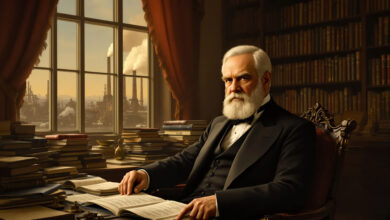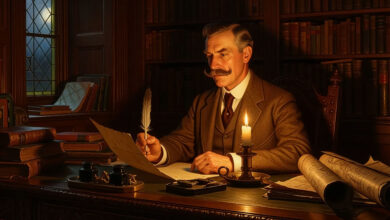Thomas More, born on 7 February 1478 in London, was one of the most remarkable figures of Tudor England. A lawyer, philosopher, author, and statesman, he is perhaps best known for his principled stand against King Henry VIII during the English Reformation. His life reflects the tensions of a changing world, caught between Renaissance humanism and emerging national power. More’s story is one of intellect, faith, political intrigue, and, ultimately, martyrdom.
Early Life and Education
More was born into a prosperous and well-connected London family. His father, Sir John More, was a successful barrister and later a judge. Young Thomas received a rigorous education, first at St Anthony’s School and then as a page in the household of John Morton, the Archbishop of Canterbury. Morton quickly recognised More’s intelligence and sent him to Oxford, where he studied at Canterbury College (now part of Christ Church). There, More excelled in Latin and Greek, embracing the spirit of Renaissance learning.
After two years at Oxford, More returned to London to study law at Lincoln’s Inn. By 1501, he had qualified as a barrister. Yet even as he pursued legal training, More was increasingly drawn to theology and classical literature. He lived for a time near a Carthusian monastery, seriously considering a monastic life. Though he ultimately chose a career in public service, this spiritual inclination remained a guiding force throughout his life.
Humanism and Writing
In the early 1500s, More became a prominent figure among English humanists. He formed a close friendship with Desiderius Erasmus, the great Dutch scholar. The two corresponded regularly and encouraged each other’s intellectual pursuits. More’s most famous literary work, Utopia (1516), was a product of this period. Written in Latin, it describes an idealised society on a fictional island, where communal ownership, religious tolerance, and rational governance flourish.
Utopia was both a critique of European politics and a philosophical exploration of justice and ethics. It captured the imagination of scholars across Europe and remains a landmark of Renaissance literature. Though its irony and satire are often debated, Utopia reveals More’s deep concern with moral responsibility and social order.
Public Career and Rise to Power
More’s reputation as a thinker and lawyer led to his rapid rise in public service. In 1510, he was appointed Undersheriff of London, a role that gave him a platform for reform and justice. His fairness and efficiency earned him respect and trust. By 1517, he had joined the king’s service as a counsellor, and in 1521, he was knighted.
More became increasingly involved in Henry VIII’s inner circle. He served as a diplomat, speaker of the House of Commons, and later as Chancellor of the Duchy of Lancaster. In 1529, following the fall of Cardinal Wolsey, More was appointed Lord Chancellor, the highest office in the land, second only to the king. He was the first layman to hold the post, and his appointment marked the peak of his political career.
As Chancellor, More was known for his integrity and intellect. However, he was also fiercely opposed to heresy and actively prosecuted Protestants, believing that religious unity was essential to social harmony. His support for the Catholic Church placed him in increasing conflict with the religious reforms sweeping Europe and England.
Conflict with Henry VIII
The defining crisis of More’s life came with Henry VIII’s decision to annul his marriage to Catherine of Aragon so that he could marry Anne Boleyn. The Pope’s refusal to grant the annulment led Henry to break from Rome and declare himself Supreme Head of the Church of England. This act marked the beginning of the English Reformation.
More, who was a devout Catholic, could not support the king’s actions. Though he resigned as Lord Chancellor in 1532, citing ill health, his actual reason was his moral objection to the king’s new policies. When Parliament passed the Act of Supremacy in 1534, requiring subjects to acknowledge the king’s religious authority, More refused to sign.
More’s refusal was not a political rebellion but a matter of conscience. He remained silent on the matter, hoping that his loyalty to the crown would be respected. However, on 17 April 1534, he was imprisoned in the Tower of London. Despite efforts to persuade him to relent, More held firm in his beliefs.
Trial and Execution
In 1535, More was tried for treason. The trial was politically charged and deeply unfair. The key evidence came from a former friend, Richard Rich, who claimed More had denied the king’s supremacy in a private conversation. More denied the accusation, but the jury found him guilty.
On 6 July 1535, Thomas More was executed on Tower Hill. He faced death with calm dignity, reportedly saying, “I die the king’s good servant, but God’s first.” His death shocked many and confirmed his reputation as a man of conscience.
Legacy and Canonisation
More’s legacy has endured for centuries. In 1935, four hundred years after his execution, he was canonised as a saint by the Catholic Church. He is now recognised as the patron saint of statesmen, lawyers, and politicians. His life is often cited as an example of principled resistance to tyranny.
The phrase “a man for all seasons” was popularised by Robert Bolt’s 1960 play about More’s life, later adapted into an Academy Award-winning film. The play presents More as a hero of integrity, a figure who stands for moral truth even in the face of political pressure.
Modern historians view More with complexity. While he is admired for his intellectual brilliance and unwavering principles, his persecution of Protestant dissenters raises difficult questions. He was a man of his time, shaped by the intense religious and political currents of the early 16th century.
Yet his central dilemma, how to reconcile personal conscience with public duty, remains powerfully relevant. More’s willingness to sacrifice everything for his beliefs continues to inspire debate, reflection, and admiration.
Final Word
Thomas More lived in a time of seismic change, when the old certainties of faith and power were being overturned. He was a Renaissance humanist who valued reason, education, and dialogue. He was a statesman who sought justice and order. And he was a man of faith who chose death rather than compromise his conscience. In the end, More’s legacy is not only that of martyr or saint, but of a thinker who grappled with the most difficult questions of his age. His life challenges us to consider what it means to live with integrity in a world of shifting values. In that sense, Thomas More truly was, and remains, a man for all seasons.
Thomas More FAQ
Thomas More (1478–1535) was an English lawyer, author, statesman, and noted Renaissance humanist. He served as Lord Chancellor to King Henry VIII but is best remembered for his opposition to the king’s divorce and break from the Catholic Church.
He is most famous for writing Utopia, a socio-political satire envisioning a perfect society, and for his principled refusal to accept Henry VIII as head of the Church of England, which led to his execution.
Utopia (1516) describes a fictional island society governed by reason and communal ownership, highlighting the flaws of contemporary European politics and offering an idealised vision of justice and order.
More refused to take the Oath of Supremacy, which acknowledged Henry VIII as the Supreme Head of the Church of England. For this act of defiance, he was tried for treason and beheaded in 1535.
Yes. In 1935, Pope Pius XI canonised him as a saint. He is also considered the patron saint of lawyers and politicians.
More was a devout Catholic and staunchly opposed the Protestant Reformation. He believed in maintaining religious unity and wrote polemics defending the Catholic faith.
His life stands as a powerful example of conscience and integrity. His ideas in Utopia influenced political philosophy, and his resistance to tyranny inspired later generations to defend freedom of belief and moral conviction.
Yes, he was married twice and had four children. He was known for being a loving and educated father, advocating for the education of his daughters at a time when this was uncommon.
He was buried in the Tower of London’s chapel after his execution, although the precise location of his remains is not definitively known.




